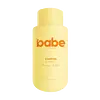What's inside
What's inside
 Key Ingredients
Key Ingredients

 Benefits
Benefits

 Concerns
Concerns

 Ingredients Side-by-side
Ingredients Side-by-side

Water
Skin ConditioningTea-Lauroyl Sarcosinate
CleansingPalm Kernelamidopropyl Betaine
CleansingCocamide Methyl Mea
Glycol Distearate
EmollientTea-Cocoyl Glutamate
CleansingCocamide Mea
EmulsifyingSodium Methyl Cocoyl Taurate
CleansingParfum
MaskingSodium Chloride
MaskingSodium Benzoate
MaskingCitric Acid
BufferingPolyquaternium-10
Guar Hydroxypropyltrimonium Chloride
Skin ConditioningPolyquaternium-7
Polyquaternium-49
Alcohol
AntimicrobialDisodium EDTA
Oryza Sativa Germ Oil
EmollientButylene Glycol
HumectantOryza Sativa Bran Oil
EmollientPrunus Armeniaca Kernel Oil
MaskingCaramel
Cosmetic ColorantPropanediol
SolventCamellia Japonica Seed Extract
Skin ConditioningBelamcanda Chinensis Root Extract
Skin ConditioningOryza Sativa Bran Extract
Skin ConditioningCamellia Sinensis Flower Extract
PerfumingSapindus Mukorossi Peel Extract
Skin ConditioningDianthus Longicalyx Seed Extract
Emulsion StabilisingTocopherol
AntioxidantWater, Tea-Lauroyl Sarcosinate, Palm Kernelamidopropyl Betaine, Cocamide Methyl Mea, Glycol Distearate, Tea-Cocoyl Glutamate, Cocamide Mea, Sodium Methyl Cocoyl Taurate, Parfum, Sodium Chloride, Sodium Benzoate, Citric Acid, Polyquaternium-10, Guar Hydroxypropyltrimonium Chloride, Polyquaternium-7, Polyquaternium-49, Alcohol, Disodium EDTA, Oryza Sativa Germ Oil, Butylene Glycol, Oryza Sativa Bran Oil, Prunus Armeniaca Kernel Oil, Caramel, Propanediol, Camellia Japonica Seed Extract, Belamcanda Chinensis Root Extract, Oryza Sativa Bran Extract, Camellia Sinensis Flower Extract, Sapindus Mukorossi Peel Extract, Dianthus Longicalyx Seed Extract, Tocopherol
Water
Skin ConditioningSodium Lauroyl Sarcosinate
CleansingDecyl Glucoside
CleansingCocamidopropyl Betaine
CleansingAloe Barbadensis Sprout
HumectantQuaternium-80
Cetrimonium Chloride
AntimicrobialGlycerin
HumectantAcrylates Copolymer
Collagen
MoisturisingPanthenol
Skin ConditioningPEG-40
HumectantHydrogenated Castor Oil
EmollientActinidia Chinensis Fruit Extract
EmollientHydrolyzed Keratin
HumectantTocopheryl Acetate
AntioxidantParfum
MaskingPPG-20 Methyl Glucose Ether
Skin ConditioningEDTA
Citric Acid
BufferingPhenoxyethanol
PreservativeEthylhexylglycerin
Skin ConditioningWater, Sodium Lauroyl Sarcosinate, Decyl Glucoside, Cocamidopropyl Betaine, Aloe Barbadensis Sprout, Quaternium-80, Cetrimonium Chloride, Glycerin, Acrylates Copolymer, Collagen, Panthenol, PEG-40, Hydrogenated Castor Oil, Actinidia Chinensis Fruit Extract, Hydrolyzed Keratin, Tocopheryl Acetate, Parfum, PPG-20 Methyl Glucose Ether, EDTA, Citric Acid, Phenoxyethanol, Ethylhexylglycerin
Ingredients Explained
These ingredients are found in both products.
Ingredients higher up in an ingredient list are typically present in a larger amount.
Citric Acid is an alpha hydroxy acid (AHA) naturally found in citrus fruits like oranges, lemons, and limes.
Like other AHAs, citric acid can exfoliate skin by breaking down the bonds that hold dead skin cells together. This helps reveal smoother and brighter skin underneath.
However, this exfoliating effect only happens at high concentrations (20%) which can be hard to find in cosmetic products.
Due to this, citric acid is usually included in small amounts as a pH adjuster. This helps keep products slightly more acidic and compatible with skin's natural pH.
In skincare formulas, citric acid can:
While it can provide some skin benefits, research shows lactic acid and glycolic acid are generally more effective and less irritating exfoliants.
Most citric acid used in skincare today is made by fermenting sugars (usually from molasses). This synthetic version is identical to the natural citrus form but easier to stabilize and use in formulations.
Read more about some other popular AHA's here:
Learn more about Citric AcidParfum is a catch-all term for an ingredient or more that is used to give a scent to products.
Also called "fragrance", this ingredient can be a blend of hundreds of chemicals or plant oils. This means every product with "fragrance" or "parfum" in the ingredients list is a different mixture.
For instance, Habanolide is a proprietary trade name for a specific aroma chemical. When used as a fragrance ingredient in cosmetics, most aroma chemicals fall under the broad labeling category of “FRAGRANCE” or “PARFUM” according to EU and US regulations.
The term 'parfum' or 'fragrance' is not regulated in many countries. In many cases, it is up to the brand to define this term.
For instance, many brands choose to label themselves as "fragrance-free" because they are not using synthetic fragrances. However, their products may still contain ingredients such as essential oils that are considered a fragrance by INCI standards.
One example is Calendula flower extract. Calendula is an essential oil that still imparts a scent or 'fragrance'.
Depending on the blend, the ingredients in the mixture can cause allergies and sensitivities on the skin. Some ingredients that are known EU allergens include linalool and citronellol.
Parfum can also be used to mask or cover an unpleasant scent.
The bottom line is: not all fragrances/parfum/ingredients are created equally. If you are worried about fragrances, we recommend taking a closer look at an ingredient. And of course, we always recommend speaking with a professional.
Learn more about ParfumWater. It's the most common cosmetic ingredient of all. You'll usually see it at the top of ingredient lists, meaning that it makes up the largest part of the product.
So why is it so popular? Water most often acts as a solvent - this means that it helps dissolve other ingredients into the formulation.
You'll also recognize water as that liquid we all need to stay alive. If you see this, drink a glass of water. Stay hydrated!
Learn more about Water